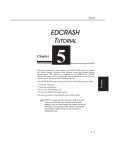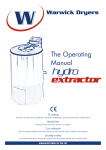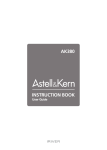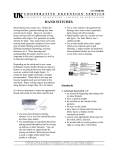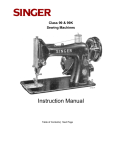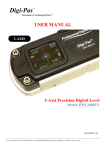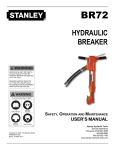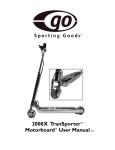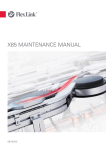Download User Manual - Trick
Transcript
MODEL NO. U616 UNIVERSAL FINGER BRAKE OPERATION, PARTS & MAINTENANCE MANUAL Model: Purchased From: Serial #: Date Received: MADE IN THE USA Distributed by: Trick-Tools 80 Truman Road Pella, IA 50219 Phone:1-877-VAN-SANT E-mail: [email protected] Here at Trick Tools we believe that our customers deserve the best value in their tool and equipment purchases. We are constantly at work searching out a variety of high quality, high performance tools to offer at the best prices possible. Our commitment to you is that we will not offer “cheap junk” anywhere on our website. You, the customer, help us to evaluate our products constantly and as soon as an ongoing quality issue is uncovered we will correct it or discontinue that product immediately. We hope to earn your continued trust. ABOUT THIS MANUAL CONTENT This manual contains information on the Roper Whitney floor mounted universal finger brake for 16 gauge material, Model U616. The contents include a machine description, safety precautions, instructions for installation, adjustment, operation, maintenance, and repair; and a parts list providing a listing of repair parts. AUDIENCE The manual is written with the experienced sheet metal operator in mind. The operator should be familiar with tooling, machine setup, materials, work methods, and setup and finished product inspection. Experienced operators not familiar with the equipment covered will be able to set up and run the machine from the manual. Novice operators can be trained from the manual, but additional instruction may be needed. It is strongly recommended that anyone using the equipment covered read the manual thoroughly, and understand the material presented. INFORMATION USAGE The setup and operating instructions are based on the intended application of the machine as defined by Roper Whitney. Use of the machine for other applications is not precluded, but use for purposes specifically excluded is not recommended, and may void warranty provisions. Material in this manual is confidential, and Roper Whitney reserves all rights in this regard. ADDITIONAL ASSISTANCE If you have questions concerning usage or operating techniques not covered by this manual, or if you encounter maintenance or repair problems, Roper Whitney field service and product support personnel can provide you with assistance. Before calling, please obtain the following information. * * * * machine type machine serial number description of application you wish to attempt description of problem you have encountered Page ii TABLE OF CONTENTS About This Manual ii Warranty Provisions iv Section 1: Safety Precautions 1 General Precautions ....................................................................................................................... 1 Safety Precautions During Operation ............................................................................................. 2 Section 2: Machine Description 3 Section 3: Specifications 4 Section 4: Receiving and Installation 5 Receiving ........................................................................................................................................ Unloading ........................................................................................................................................ Unpacking ....................................................................................................................................... Site Preparation .............................................................................................................................. Setting the Brake ............................................................................................................................ Leveling the Brake .......................................................................................................................... Anchoring the Brake ....................................................................................................................... Installing the Counterweights ......................................................................................................... Section 5: Setup 5 5 5 6 7 7 7 8 9 Setting Clamping Pressure ............................................................................................................. 9 Adjusting for Material Thickness ................................................................................................... 10 Setting Up for Narrow or Offset Bends ......................................................................................... 11 Setting Up the Bend Angle Stop................................................................................................... 12 Section 6: Operation 13 General Instructions ...................................................................................................................... Clamping the Material ................................................................................................................... Bending the Material ..................................................................................................................... Bending of Multiple Thicknesses .................................................................................................. Hemming ....................................................................................................................................... Section 7: Periodic Maintenance 13 13 14 14 15 16 Lubricating Rotating Components ................................................................................................ Lubricating Sliding Components ................................................................................................... Lubricating Adjusting Nuts and Screws ........................................................................................ Adjusting the Clamping Collars..................................................................................................... Section 8: Maintenance Adjustments 16 16 16 17 18 Brake Crowning Adjustments ....................................................................................................... 18 Preloading Adjustment .................................................................................................................. 20 Section 9: Repair Parts List 22 Page iii FOREWORD This manual has been prepared for the owner and operators of Roper Whitney No. U616 brake. Its purpose, aside from operations instructions, is to promote safety through the use of accepted operating procedures. Read all instructions thoroughly before operating the brake. Also contained in this manual is the parts list for your brake. It is recommended that only Roper Whitney or factory authorized parts be used as replacements. Warranty Statement: 3 YEAR LIMITED WARRANTY Roper Whitney (“Manufacturer”) warrants, commencing with the date of shipment to first end-user (“Customer”) and for a period of thirty-six (36) months thereafter, all machinery and parts manufactured by Manufacturer to be free of defects in workmanship and material. This warranty remains in force for the above time period only if all of Manufacturer’s operational procedures are followed and recommended maintenance is performed. If, within such warranty period, any machinery or parts manufactured by Manufacturer shall be proved to Manufacturer’s satisfaction to be defective, such machinery or parts shall be repaired or replaced, at Manufacturer’s option. All warranty claims are made F.O.B Manufacturer’s plant, providing such machinery or parts are returned freight prepaid to Manufacturer’s plant or designated service center for Manufacturer’s inspection. All failed parts or components must be returned to Manufacturer prepaid for inspection before credit will be issued for new parts or components. Manufacturer’s obligation hereunder shall be confined to such repair or replacement and does not include any charges, direct or indirect, for removing or replacing defective machinery or parts. No warranty shall apply to machinery, or parts or accessories, which have been furnished, repaired, or altered by others so as, in Manufacturer’s judgment, to affect the same adversely or which shall have been subject to negligence, accident or improper care, installation, maintenance, storage, or other than normal use or service, during or after shipment. No warranty shall apply to the cost of repairs made or attempted outside of Manufacturer’s plant or designated service center without Manufacturer’s authorization. No warranty shall apply with respect to machinery or part not manufactured by Manufacturer, including but not limited to motors, accessories, electrical and hydraulic components, if such machinery or part is subject to warranty by the manufacturer of such machinery or part. No warranty claims by Customer will be honored with respect to any machinery or part from which the name and date plate has been removed or is otherwise no longer located or exhibited on such machinery or part. THE FOREGOING WARRANTIES ARE IN LIEU OF ALL OTHER WARRANTIES EXPRESSED OR IMPLIED, INCLUDING, BUT NOT LIMITED TO, ANY IMPLIED WARRANTY OF MERCHANTABILITY AND IMPLIED WARRANTY OF FITNESS FOR A PARTICULAR PURPOSE. MANUFACTURER SHALL NOT BE SUBJECT TO ANY OTHER OBLIGATIONS OR LIABILITIES WHATSOEVER WITH RESPECT TO MACHINERY, PARTS, ACCESSORIES, OR SERVICES MANUFACTURED OR FURNISHED BY IT OR ANY UNDERTAKINGS, ACTS, OR OMISSIONS RELATING THERETO. UNDER NO CIRCUMSTANCES SHALL MANUFACTURER BE LIABLE FOR ANY CONSEQUENTIAL OR OTHER DAMAGES, EXPENSES, LOSSES, OR DELAYS HOW SO EVER CAUSED. THERE ARE NO WARRANTIES THAT EXTEND BEYOND THE DESCRIPTION ON THE FACE HEREOF. Note: Consumable tooling is not covered under the 3 year manufacturer’s warranty. RETURN OF THE PRODUCT REGISTRATION CARD FURNISHED WITH THE PRODUCT IS NECESSARY TO OBTAIN WARRANTY COVERAGE THEREON. CARD MUST BE FULLY COMPLETED, SIGNED BY THE PURCHASER, AND IF APPLICABLE, SIGNED BY THE DISTRIBUTOR. RETURN REGISTRATION CARD TO: Page iv SAFETY LABELS Do not operate the U616 Brake without the proper safety labels in place. If your machine is missing the following labels, please contact Roper Whitney Co. or your authorized Roper Whitney distributor to order. SECTION 1 SAFETY PRECAUTIONS Before using the Roper Whitney manual brake, carefully read and fully under stand the safety precautions outlined in this section. GENERAL PRECAUTIONS pertain to the general workplace, and to the attitudes and work habits you bring to the job. SAFETY PRECAUTIONS DURING OPERATION pertain to work on the brake, and are repeated in other areas of the manual where they pertain. Do not consider this section to be all-inclusive on the subject of safety. It is intended to be a general guide to safety practices as they pertain to the machines covered by this manual. No set of guidelines can substitute for a common-sense, informed, proficient, safety-conscious attitude on your part. GENERAL PRECAUTIONS Notify management or supervision whenever you feel there is any hazard involving the equipment or the performance of your job. Never permit untrained individuals to operate this equipment without close supervision. Be sure you know and understand the task at hand, and the hazards associated with it. Observe and follow safety instructions for your work area. Pay special attention to posted warnings, and warning labels on the equipment. Do not place speed above safety. Wear appropriate clothing. Loose or hanging clothing or jewelry, finger rings, etc. can be hazardous. Use the appropriate safety equipment, such as eye and hearing protection, and safety-toe shoes. If gloves are worn to protect from cuts, be sure they are snug-fitting and not likely to be snagged by moving equipment. Keep the work area neat and orderly. Be sure it is well lit, that extra tools are put away, trash and refuse are in the proper containers, and dirt, chips or debris have been removed from the working areas of the machine. Be sure the floor area is clean and dry, and that extension cords and similar trip hazards have been removed. Use the proper tools for the job. Inspect them before use to see that they are in good working condition. Replace broken or defective tools and equipment. Use only approved cleaning materials: do not use explosive or flammable liquids to clean the machine. Discard used cleaning materials in the appropriate containers. Do not use compressed air to clean debris, chips, dirt, or grit from the machine, or from your clothing. Remove chips and grit from the machine with a suitable brush; never with your hands. Page 1 SAFETY PRECAUTIONS DURING OPERATION Do not attempt to operate the brake in excess of its rated capacity. Do not attempt to form wire, nails, rods or pipe on the machine. Avoid any pinch points created by movement of the machine's components. Exercise care around the bending apron counterweights. Stand clear of the ends of the brake during the bend cycle or whenever the bending apron is moved. Do not loosen the set screws securing the counterweight rods while the bending apron is in the vertical position. WARNING SERIOUS INJURY MAY OCCUR The counterweight and rod can drop suddenly through the holder. Always use the apron lift handles to apply the bending force. Under no circumstances use the counterweight rods for leverage. Failure to heed this warning can cause personal injury or damage to the counterweight rods. Always stand clear of the apron lift handle travel arc during the bend cycle to avoid being struck by the handles. WARNING SERIOUS INJURY MAY OCCUR Avoid pinch points created by the clamping and bending components. Always stand clear of clamping handles. If the brake has not been properly adjusted for material thickness; clamping action on one end of the brake may cause the opposite clamping handle to snap forward due to the twisting stress created on the upper beam. (this can also indicate that the clamping collars need adjustment. Refer to Section VII, Periodic Maintenance.) When opening the upper beam make sure the handles are moved to the horizontal position to avoid accidental forward movement of the handles caused by the weight of the upper beam. If you observe unusual noises or vibrations during machine operation, check the machine condition immediately. Do not attempt to operate the equipment further until the causes of unusual behavior have been found and corrected. Page 2 SECTION 2 MACHINE DESCRIPTION Roper Whitney floor mounted Universal Finger Brakes are precision machines for use in bending mild steel and other sheet metals, including aluminum, brass, bronze, copper, duralumin; lead, monel metal, silver, carbon and stainless steel within rated capacity. The brakes are rated to form a 1” minimum wide flange over entire length of brake on a single thickness of material of the rated gauge capacity with work angle support installed. Bending capacities are reduced by four (4) gauges when the apron work support is removed. Major components are shown in Figure 1. Fabricated of sturdy steel plate with appropriate gussets, braces and trusses; three basic longitudinal members (upper-beam, lower-beam and bending leaf/ apron) control the clamping pressure and stress incurred in overcoming the yield strength of the material being formed. Provisions for adjusting clamping force and tensioning of the longitudinal members are incorporated in the design of the bending brakes. TENSIONING MEMBERS COUNTERWEIGHT UPPER BEAM & CLAMP FINGERS COUNTERWEIGHT CLAMPING LEVER CLAMPING LEVER BENDING APRON TENSIONING MEMBERS LOWER BEAM AND MACHINE BED Figure 1. Major Components of the Universal Finger Brake. Page 3 SECTION 3 SPECIFICATIONS FEATURE MODEL U616 Bed Length 73 in. Capacity on mild steel, 1” flange With bending bar and angle in place With bending angle removed With bending bar and angle removed 16 Ga. 20 Ga. 24 Ga. Minimum Reverse Bend (bending bar and angle removed) 1/4 in. Maximum lift of beam 1 5/8 in. Front to Rear Adjustment of Beam 1 1/8 in. Approximate Shipping Weight 1350 lbs. Packing Heavy wood skids and blocking with a plastic cover Page 4 SECTION 4 RECEIVING AND INSTALLATION RECEIVING When you receive your finger brake, check immediately for obvious damage, which may have occurred during transit, to the skidding material or to the brake itself. Also check to see that all material listed on the bill of lading is present. Since Roper Whitney equipment is normally sold F.O.B., factory in Rockford, IL, our responsibility for transit damage ceases when the transportation company signs the bill of lading indicating it has received the items listed in good condition. Report discovered damage or shortages to the carrier. Make a notation on the delivery waybill, and have the delivering driver sign it, acknowledging the damage or shortage. Submit claims for repair or replacement to the carrier; include any extra shipping charges. Notify Roper Whitney Company promptly of any damage or shortages. If you discover concealed damages or shortages after the carrier has departed, you may still file a claim for concealed damage. This should be done as quickly as possible. Again, notify Roper Whitney Company promptly of such damages or shortages. UNLOADING The brake is shipped on a skid of 3" x 6" wood timbers. It is secured to this skid with four (4) carriage bolts, which should remain secured while the machine is unloaded and moved about. The skid and brake may be moved using a suitable fork lift. WARNING WHEN IN MOTION, THE SKIDDED BRAKE MAY BE TOP HEAVY When lifting or moving the skidded brake with a forklift, secure the brake laterally to the forklift. UNPACKING The two counterweight arms (rods) and their counterweights are mounted separately on the wooden skid for shipment. Remove these from the skit and set to one side. WARNING THE COUNTERWEIGHT ARMS AND COUNTERWEIGHTS ARE HEAVY Use care when removing them from the skid to avoid injury. Page 5 The clamping handles at each end of the brake are wrapped and wired in the down position to prevent damage and to prevent the handles from being used to move the brake. Remove the wires and wrapping. Wooden blocks are positioned between the upper and lower beam jaws to prevent damage during shipment. Lift the clamping handles and remove the blocks. The bending leaf (apron), is wired to the center truss stud of the lower beam to prevent movement during transit. Remove the wire. Remove the four (4) carriage bolts, nuts, and washers securing the brake to the skidding. DO NOT REMOVE THE BRAKE FROM THE SKID AT THIS TIME. WARNING AND CAUTION SERIOUS INJURY CAN RESULT OR THE BENDING BRAKE CAN BE DAMAGED Do not operate the brake on the skid. The brake must be attached to the floor. The machine is top heavy and can tip if not securely anchored. The skid does not provide a suitable anchoring platform. SITE PREPARATION The brake must be placed on a firm floor which does not sag and which does not have any “spring” to it. The floor must be generally level, with no twisting or unevenness in the surface. The floor must also be capable of accepting 1/2” lag screws or bolts for the purpose of securing the brake. There must be adequate area around the brake for free movement of the operator and the handling of large sheets of metal. Allow 4 to 6 feet behind the brake, 6 to 8 feet in front of the brake, and 3 feet on either end of the brake. To move the brake off the skid, and to its mounting position, use an overhead crane or a fork lift with the forks above the brake. If a fork lift is used, secure a lifting hook on the lift forks. Pass a sling under brake and secure each end on the lifting hook as shown in Figure 2. CAUTION THE BENDING BRAKE CAN BE DAMAGED Do not move the brake using lift truck forks directly under any machine members. Page 6 SETTING THE BRAKE Using the overhead crane, lift the brake from the skid and place it in its desired location. Be sure the brake is properly balanced. WARNING THE BRAKE TENDS TO BE TOP HEAVY AND CAN TWIST IN THE SLING Use care when moving the brake from the skid to avoid injury. Figure 2. The proper lifting method for moving the brake. LEVELING THE BRAKE Raise the upper beam to its maximum height using the eccentric lifting levers. (See Figure 2) Place an accurate spirit-level on the bed at each end of the bar. Shim under the legs of the brake until the bed bar shows the machine is level front-to-rear. This will remove any twist from the bed. Side-to-side leveling is not necessary to proper operation of the brake. ANCHORING THE BRAKE Anchor the leveled brake to the floor using 1/2” lag screws or bolts through the leg mounting holes. Tighten securely, making sure pressure is exerted on the leveling shims. Page 7 INSTALLING THE COUNTERWEIGHTS Have an assistant raise the bending apron to the horizontal position, and hold it in that position while the counterweights hare installed. Install a counterweight in the mounting hole in each end of the bending apron. Adjust the counterweights so that they balance the bending apron in the horizontal position. Tighten two set screws securely on each counterweight shaft. WARNING THE COUNTERWEIGHTS ARE HEAVY Use care when installing the counterweights to avoid injury. Be sure the set screws are tightened enough so the counterweights will not drop when the bending apron is returned to the vertical position. Page 8 SECTION 5 SETUP Your new Roper Whitney Brake is pre-set and should not require field adjustment. The machine has been adjusted and pretensioned at the factory. SETTING CLAMPING PRESSURE Excessive clamping pressure is not required or desirable. It has a tendency to counteract the normal preloading adjustments and may interfere with obtaining straight and uniform bends. Use only enough clamping pressure to keep the material from slipping. TOGGLE ASSEMBLY UPPER TOGGLE PIN LOCK NUT CLAMPING LEVER TOGGLE ANCHOR LOWER TOGGLE PIN LOCK NUT Figure 3. Clamping Pressure Adjustments. Set-up adjustments are for clamping pressure, material thickness, setting up for narrow or offset bends, setting bend angle control, and setting up of the optional rear material stops. Should your brake require adjustment, follow instructions below: Be sure the gauge thickness of the material to be formed to is within the rated capacity of the machine. Then adjust clamping pressure as follows: 1. At each end of the brake, loosen both toggle pin lock nuts slightly before beginning adjustment (see Figure 3). 2. Place small sample pieces of the material to be formed between the upper beam radius bar and the bed at each end of the machine. Clamp in position. 3. At each end of the machine, tighten the lower toggle pin lock nut against the toggle anchor just enough to hold material firmly when the clamping lever is against the forward stop (see Figure 3). Page 9 SETTING CLAMPING PRESSURE ADJUSTING FOR MATERIAL THICKNESS 4. At each end of the machine, tighten upper toggle pin lock nut against the toggle anchor (see Figure 3). 5. At each end of the machine, pull the clamping lever forward against the stop. Each end should require equal effort. Adjust one end, if necessary, according to the general procedure above. Under normal circumstances, clearance between the apron edge and the upper beam radius bar should be approximately (2) times the material thickness for 16 ga. mild steel. For lighter gauge material, less clearance is required. One and a half (1 1/2) times material thickness is usually sufficient. Soft material, such as aluminum, may be formed with a clearance equal to the material thickness. CAUTION THE BENDING BRAKE CAN BE DAMAGED Clearance must never be less than the material thickness. THICKNESS ADJUSTMENT CLAMPING SCREW CLAMPING LEVER THICKNESS ADJUSTMENT SCREW ANGLE STOP COLLAR ANGLE STOP COLLAR SET SCREW ANGLE STOP STUD ANGLE STOP ROD Figure 4. Material Thickness and Angle Adjustments. Make the adjustment as follows: 1. With the upper beam lowered to the normal operating position, but not clamped tightly against the bed, loosen the thickness adjustment clamping screws located on both ends of the brake (see Figure 4). 2. Raise the apron to the 90 degree position. Page 10 ADJUSTING FOR MATERIAL THICKNESS SETTING UP FOR NARROW OR OFFSET BENDS 3. Move the upper beam forward or back until proper clearance is achieved by turning the thickness adjusting screw located at rear of the leg bracket on each end of the machine (see Figure 4). Final adjustment must always be toward the front of the brake to remove backlash from the adjusting screws. 4. Retighten the clamping screw on each end of the machine (see Figure 4). It is sometimes necessary to remove the bending reinforcing angle to make narrow or offset bends. In extreme conditions, it may also be necessary to remove the bending bar. The bending bar is made of tough, wear resistant material to protect the edge of the apron and should be removed only when absolutely necessary to make tight reverse bends. Removing the bending reinforcing angle reduces capacity by four (4) gauges. The rated 16 ga. capacity is reduced to 20 ga. capacity. Removing both the bending reinforcing angle and the bending bar reduces the 16 ga. capacity to 24 gauge capacity. BENDING REINFORCING ANGLE BENDING BAR (LOCATED BEHIND THE BENDING REINFORCING ANGLE) Figure 5. Removal of the Bending Reinforcing Angle and the Bending Bar Remove the bending reinforcing angle and the bending bar as follows: 1. Support the bending reinforcing angle and remove retaining screws. Withdraw the angle from the machine (see Figure 5). 2. Support the bending bar and remove retaining screws. Withdraw the bar from the machine (see Figure 5). 3. After the bending operation is complete, be sure to replace the removed components, attaching them with the retaining screws. Tighten the screws securely. Page 11 SETTING UP THE BEND ANGLE STOP The bend angle stop can be adjusted for multiple or precision bends. Adjust the angle stop as follows: 1. Loosen the angle stop collar set screw and move the angle stop collar out toward the end of the angle stop rod. (See Figure 4.) 2. Have an assistant move the apron to the desired position and hold it while you adjust the collar. Be sure to take spring-back into account when setting the angle. 3. Move the angle stop collar against the angle stop stud and tighten the angle stop collar set screw to retain it in that position. Page 12 SECTION 6 OPERATION GENERAL INSTRUCTIONS Operation of the brake is entirely manual, and the operator has full control of the operation at all times. Do not attempt to operate the brake in excess of its rated capacity. Do not attempt to form wire, nails, rods or pipe on the machine. If you are bending large sheets of material which are difficult to handle, you may wish to use an assistant to help in loading, clamping, and bending. If you observe unusual noises or vibrations during machine operation, check the machine condition immediately. Do not attempt to operate the equipment further until the causes of unusual behavior have been found and corrected. WARNING PINCH POINTS CAN CAUSE SERIOUS INJURY Avoid any pinch points created by movement of the machine’s components. CLAMPING THE MATERIAL Insert the material to be bent under the upper beam clamping mechanism, lining up both sides so they are even with the upper beam. Position short pieces of material in the center of the brake to equalize strain during bending. Clamp the material by lowering the upper beam with the clamping levers. If the brake has not been properly adjusted for material thickness; clamping action on one end of the brake may cause the opposite clamping handle to snap forward due to the twisting stress created on the upper beam. When opening the upper beam make sure the handles are moved to the horizontal position to avoid accidental forward movement of the handles caused by the weight of the upper beam. WARNING THE UPPER BEAM CLAMPING MECHANISM CAN CAUSE SERIOUS INJURY Always stand clear of the clamping handles. Do not place fingers near or under the upper beam. Page 13 BENDING THE MATERIAL Bend the material to the desired bend angle using the apron lift handles to apply the bending force. Under no circumstances use the counterweight rods for leverage. If the material being bent is long and protrudes from the machine, lift it during the bending operation to avoid creases or crimps caused by material weight. WARNING THE COUNTERWEIGHTS AND CLAMPING HANDLES CAN CAUSE INJURY Always stand clear of the ends of the brake during the bend cycle. Always stand clear of the apron lift handle travel arc during the bend cycle. CAUTION THE COUNTERWEIGHT RODS CAN BE DAMAGED Using the counterweight rods to apply bending force can damage them. BENDING OF MULTIPLE THICKNESSES To avoid adjusting for every piece on a run of parts, do all the single-thickness bending operations first, then adjust and do the multiple thickness bending. Never bend against hems or seams until an adjustment has been made to compensate for the clamping of multiple thicknesses of material. Never bend against hems or seams until the upper beam is set back for clearance of the multiple thicknesses of material. See SETUP, SECTION 5, for adjustment instructions. CAUTION MACHINE COMPONENTS CAN BE DAMAGED Failure to compensate for multiple thicknesses of material may result in breakage of the clamping mechanism. Failure to set the upper beam back for extra clearance may result in indentations on the upper beam jaw. Page 14 HEMMING Hemming is the most difficult operation to control accurately on a hand brake. Hemming creates pressure loads on the machine different than those created by regular bending, and optimum results will not be obtained using the same machine preloading for both hemming and bending. In factory tests, closing 24 Ga. material all the way along was done easily with no change in the preloading settings used for bending. 22 Ga. material was open about 1/32” in the middle and hems in 20 Ga. had an opening in the middle of just under 1/16” under like conditions. If you must have tight hems in material heavier than 24 Ga., do all of the bending first, adjust the machine for hemming, and close the hems in a second operation. HEMMING... ...THE TRADITIONAL METHOD Hemming is traditionally done by making a maximum bend of about 135 degrees and flattening it between beam and bed by lowering the clamping levers. This approach may require additional preloading in order to close the hem tightly at the center. Increase the preload by tightening the upper beam tensioning adjusting nut (See Figure 9). It also requires reducing clamping pressure to allow for multiple thicknesses of material. Reduce clamping pressure by slackening the lower toggle pin adjusting nut and tightening the upper toggle pin adjusting nut (See Figure 10). HEMMING... ...ANOTHER WAY Remove the workpiece from the machine after bending. Close the machine by clamping the beam down on the bed with the clamping levers. Place the workpiece on the front surface of the upper beam. Swing the apron up and close the hem by squeezing the workpiece between the machined surface of the apron and the upper front surface of the radius bar. This may feel awkward at first, especially if you are accustomed to hemming in the traditional manner, but it will get easier with practice and the end result is far superior to the traditional way. It may be necessary to move the upper beam 1/8” to 3/16” to the rear to allow clearances for the hem between apron and front of beam. See SETUP, SECTION 5, for adjustment instructions. Page 15 SECTION 7 PERIODIC MAINTENANCE LUBRICATING ...ROTATING COMPONENTS Grease fittings are provided for rotating components where wear may occur. Use a medium weight bearing grease, such as SAE No. 30, and grease weekly when the brake is being used. The rotating components are: the clamping lever assembly, the apron hinge assembly (2 fittings), and the toggle pin bushing. One set of these components is found on each end of the machine. Location of these fittings is shown in Figure 7. ...SLIDING COMPONENTS Grease sliding components weekly as well, using general purpose grease, or equivalent. These components include the clamping pin bushings and the slots in which they ride (see Figure 7). CLAMPING LEVER ASSEMBLY APRON HINGE ASSEMBLY (2 FITTINGS) SLIDE PIN BUSHINGS TOGGLE PIN BUSHING Figure 7. Grease Lubrication Points on the Brake ...ADJUSTING NUTS AND SCREWS The upper and lower beam tensioning screws (see Figure 9) are under heavy load and must not be allowed to run dry. Keep them lubricated with an antiseize compound. If the machine is frequently readjusted, the lower apron tensioning lock nut (see Figure 12), and upper beam tensioning lock nut, and the lower beam tensioning lock nuts (see Figure 9), they should be kept lubricated with an anti-seize compound. Page 16 ADJUSTING THE CLAMPING COLLARS The retaining system used to hold the clamping levers in the open position require periodic adjustment. Adjust the collars using the following procedure: CLAMPING LEVER CLAMPING COLLAR CLAMPING COLLAR SET SCREW (ON O.D. OF LOCK CLAMPING WASHER COLLAR) Figure 8. Adjusting the Clamping Lever Collars 1. Slightly loosen the set screws retaining the clamping collars on each end of the machine. Set screws should be loose enough to permit adjustment of the clamping collars, but not so loose as to permit loss of position on the clamping collars when the clamping levers are moved. 2. Tighten the clamping collars by turning them clockwise, until you are unable to move the clamping levers to clamp material. 3. Back off the clamping collars by turning them counterclockwise until you can move the clamping levers to clamp material. The collars are properly adjusted when one lever can be unclamped, and the lever at the opposite end of the machine remains clamped. It may require several adjustments at each end of the machine to achieve the proper tension. During these adjustments, be sure the set screws remain tight enough to prevent loss of position by the clamping collars when the clamping levers are moved. 4. When the collars are properly adjusted, tighten the set screws securely to retain the clamping collars in place. Page 17 SECTION 8 MAINTENANCE ADJUSTMENTS BRAKE CROWNING ADJUSTMENTS When the machine does not bend properly, it is sometimes necessary to readjust the crown on the beams. Use the following procedure: 1. Relieve all tension on the upper beam tensioning nuts and on the upper beam tensioning screw (see Figure 9). 2. Lower the upper beam onto the bed. Loosen lower toggle pin adjusting nut until there is 1/4” of space between bottom of the toggle anchor and the lower toggle pin adjusting nut (see Figure 10). 3. Adjust the upper beam and lower beam tensioning screws finger tight; and then tighten each with a wrench approximately one full turn (five flats) (see Figure 9). 4. Adjust the upper beam tensioning nuts finger tight, and then tighten each with a wrench approximately one full turn (five flats) (see Figure 9). 5. When looking from the rear of the brake, the upper beam and the bed should be in contact at the center and showing a crack of light at each end (see Figure 11). If less light shows at one end, loosen the rear floor bolt at that end and shim under the leg until the light shows evenly at both ends. 6. Tighten the lower toggle pin adjusting nut against the bottom of the toggle anchor (see Figure 11). UPPER BEAM TENSIONING NUTS UPPER BEAM TENSIONING SCREW LOWER BEAM TENSIONING SCREW LOWER BEAM TENSIONING NUT Figure 9. Upper Beam and Bed Tensioning Components. Page 18 BRAKE CROWNING ADJUSTMENTS TOGGLE ANCHOR LOWER TOGGLE PIN ADJUSTING NUT Figure 10. Upper Beam Clamp Adjusting Components. THE BEAM AND THE BED MUST BE IN CONTACT AT THE CENTER OF THE MACHINE BEAM BED EXAGGERATED VIEW OF GAP AT EACH END OF THE MACHINE THE GAP MUST BE EQUAL AT BOTH ENDS Figure 11. Proper Clearance Between the Upper Beam Clamp and the Bed. Page 19 PRELOADING ADJUSTMENT Once the brake crown has been set, the brake must be adjusted to produce straight bending and a uniform radius. Follow the procedure below: 1. Loosen the apron tensioning nuts on the apron, (see Figure 12) and the upper and lower beam tensioning nuts (see Figure 9). 2. Loosen the upper and lower beam tensioning screws (see Figure 9). 3. Raise the upper beam to its maximum open height. 4. Check the top edge of apron in relation to the top surface of the bed. The top edge of apron must be 1/64” below the top surface of the bed at each end. If not, loosen the hinge bolts and adjust the apron up or down using the apron jack screws (see Figure 13). After the apron edge is adjusted to the proper position, be sure to retighten the hinge bolts. 5. Adjust the upper and lower beam tensioning screws finger tight; and then tighten each with a wrench approximately one full turn (five flats) (see Figure 9). APRON TENSIONING ADJUSTING NUT Figure 12. Preloading Adjusting Components. 7. Tighten lower beam tensioning nut until the edge of the bed is 1/64” above the top edge of the apron at the center (see Figure 9). The edges of the bed and apron will then be parallel from end to end, with the edge of the bed 1/64” higher than the apron edge. Page 20 PRELOADING ADJUSTMENT 8. Tighten upper and lower beam tensioning nuts finger tight; and then, using a wrench, tighten each from 1/4 to 1/2 turn. The bending brake is now properly adjusted for its rated gauge capacity in mild steel. HINGE BOLTS APRON JACK SCREWS Figure 13. Apron Adjusting Components. Page 21 SECTION 9 REPAIR PARTS The table below identifies parts which may be replaced on the Roper Whitney Universal Finger brake. Parts may be ordered directly from your Roper Whitney distributor. If you have no distributor in your area, you may order the parts directly from the company. Common hardware items such as screws and nuts may be purchased locally, so long as the items purchased are of equivalent quality to those originally supplied with the machine. The Ref. No. column is keyed to the exploded view on the facing page. The Part Number columns provide part numbers for replacement parts for each model brake covered by this manual. The Part Name column provides a short descriptive name for each replacement part. The Qty. column identifies the quantity required for replacement. Ref. No. 1 2 3 4 5 6 7 8 9 10 11 12 13 14 15 16 17 Part Number 257020055 757030144 613012133 757180143 601012271 679033107 457500069 457500070 657012641 679033107 643023007 621012271 757160011 600134000 657356334 757280074 621012266 Part Name Qty. Apron Assembly Bending Bar Screw, Flat Head, 5/16-18 by 1 inch Bending Angle Cap Screw, Hex Head, 1/2-13 by 1 inch Washer, Lock, 1/2-inch Hinge Assembly, right hand Hinge Assembly, left hand Cap Screw, Hex Head, 1/2-13 by 1-3/4 Washer, Lock, 1/2-inch Nut, Hex, 1/2-13 Screw, Set, Socket, 1/2-13 by 1 Pin, Hinge Fitting, Grease, Straight Handle Grip Counterweight and Rod Assembly Screw, Set, Cup Point, 1/2-13 by 1/2 1 1 12 1 7 7 1 1 12 12 12 4 2 6 2 2 4 continued.... Page 22 Figure 14. Exploded View of Replacement Parts Page 23 ....continued from page 22 Ref. No. 18 19 20 21 22 23 24 25 26 27 28 29 30 31 32 33 34 35 36 37 38 39 40 41 42 43 44 45 46 47 48 49 50 51 52 Part Number 257020054 757080015 656164302 457080076 257090053 757130036 600083604 600073516 757160038 757260072 621012125 666023007 600134006 657164324 757080018 757160096 671023010 657033154 645023010 757860140 757860141 757080009 757160142 757030003 757030004 657356334 657245118 679033112 657000390 757730005 757730006 611012410 678033110 257940052 617012266 Part Name Qty. Beam Bushing, Slide Pin Ring, Retaining, Slide Pin Bushing Bushing, Eccentric Bed Assembly Stop Rod, Apron Pin, Clevis Pin, Cotter, 3/32 by 1-inch Stud, Apron Stop Collar, Apron Stop Screw, Apron Stop Collar, 5/16-18 by 5/16 Nut, Apron Stop Stud Fitting, Grease, 45 Degree Ring, Retaining Bushing, Lower Toggle Pin Pin, Lower Toggle Toggle Nut, lower Washer, Spring Toggle Nut, Upper 3/4-16 Toggle Assembly, Right Hand Toggle Assembly, Left Hand Bushing, Toggle (included with items 37 and 38) Stud, 3/4-16 x 6.5-inch Clamping Lever, Right Hand Clamping Lever, Left Hand Handle, Grip Bearing, Thrust Washer, Split Lock Collar, Clamping Slide Plate, Right Hand Slide Plate, Left Hand Screw, Clamping Washer, Clamping Screw Adjusting Screw Assembly Screw, Set, Socket Head, 1/2-13 by 1/2 Page 24 1 2 2 2 1 1 1 1 1 1 1 1 2 2 2 2 2 2 4 1 1 2 1 1 2 4 2 2 1 1 2 4 2 2 18 19 20 21 22 52 51 47,48 37,38 39 43 41,42 30 29 28 50 49 40 23 14 36 27 25 26 31 32 24 35 33 34 Figure 15. Exploded View of Replacement Parts Page 25 44 45 46 Figure 16. Exploded View of Finger Assemblies 1A 1C 1B 3 BEAM 2A 2B 2C 4 SECTION A-A (IDENTICAL FOR ALL THREE SIZES) Ref. No. 1A 1B 1C 2A 2B 2C 3 4 Part Number 757010080 757010079 757010078 757360077 757360076 757360075 617012269 613012133 Part Name Finger Holder, 5” Finger Holder, 4” Finger Holder, 3” Finger Tip, 5” Finger Tip, 4” Finger Tip, 3” Screw, SSFP 1/2-13 x 3/4” Screw, SHF 5/16-18 x 1” Page 26 Qty. 1 1 1 1 1 1 2 1 NOTES

































